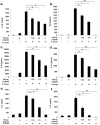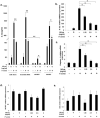Nitric Oxide-Releasing Nanoparticles Prevent Propionibacterium acnes-Induced Inflammation by Both Clearing the Organism and Inhibiting Microbial Stimulation of the Innate Immune Response
- PMID: 26172313
- PMCID: PMC4640998
- DOI: 10.1038/jid.2015.277
Nitric Oxide-Releasing Nanoparticles Prevent Propionibacterium acnes-Induced Inflammation by Both Clearing the Organism and Inhibiting Microbial Stimulation of the Innate Immune Response
Abstract
Propionibacterium acnes induction of IL-1 cytokines through the NLRP3 (NLR, nucleotide oligomerization domain-like receptor) inflammasome was recently highlighted as a dominant etiological factor for acne vulgaris. Therefore, therapeutics targeting both the stimulus and the cascade would be ideal. Nitric oxide (NO), a potent biological messenger, has documented broad-spectrum antimicrobial and immunomodulatory properties. To harness these characteristics to target acne, we used an established nanotechnology capable of generating/releasing NO over time (NO-np). P. acnes was found to be highly sensitive to all concentrations of NO-np tested, although human keratinocyte, monocyte, and embryonic zebra fish assays revealed no cytotoxicity. NO-np significantly suppressed IL-1β, tumor necrosis factor-α (TNF-α), IL-8, and IL-6 from human monocytes, and IL-8 and IL-6 from human keratinocytes, respectively. Importantly, silencing of NLRP3 expression by small interfering RNA did not limit NO-np inhibition of IL-1 β secretion from monocytes, and neither TNF-α nor IL-6 secretion, nor inhibition by NO-np was found to be dependent on this pathway. The observed mechanism by which NO-np impacts IL-1β secretion was through inhibition of caspase-1 and IL-1β gene expression. Together, these data suggest that NO-np can effectively prevent P. acnes-induced inflammation by both clearing the organism and inhibiting microbial stimulation of the innate immune response.
Conflict of interest statement
Figures






References
-
- Bellew S, Thiboutot D, Del Rosso JQ. Pathogenesis of Acne Vulgaris: What's New, What's Interesting and What May Be Clinically Relevant. J Drugs Dermatol. 2011;10:582–5. - PubMed
-
- Bennett BM, McDonald BJ, Nigam R, et al. Biotransformation of organic nitrates and vascular smooth muscle cell function. Trends Pharmacol Sci. 1994;15:245–9. - PubMed
-
- Blecher K, Martinez LR, Tuckman-Vernon C, et al. Nitric oxide-releasing nanoparticles accelerate wound healing in NOD-SCID mice. Nanomedicine 2012 - PubMed
-
- Castro G, Ferreira L. Novel vesicular and particulate drug delivery systems for topical treatment of acne. Expert Opin Drug Deliv. 2008;5:665–79. - PubMed
Publication types
MeSH terms
Substances
Grants and funding
- 1RC2A1087612-01/RC/CCR NIH HHS/United States
- R01 ES016896/ES/NIEHS NIH HHS/United States
- R01 AI056070/AI/NIAID NIH HHS/United States
- P30 ES003850/ES/NIEHS NIH HHS/United States
- P30 ES03850/ES/NIEHS NIH HHS/United States
- R01 AR053542/AR/NIAMS NIH HHS/United States
- T32 ES0007060/ES/NIEHS NIH HHS/United States
- R01 ES017552/ES/NIEHS NIH HHS/United States
- ES016896-01/ES/NIEHS NIH HHS/United States
- ES017552-01A2/ES/NIEHS NIH HHS/United States
- T32 ES007060/ES/NIEHS NIH HHS/United States
- P01 HL110900/HL/NHLBI NIH HHS/United States
- P30 AI028697/AI/NIAID NIH HHS/United States
LinkOut - more resources
Full Text Sources
Other Literature Sources
Miscellaneous

